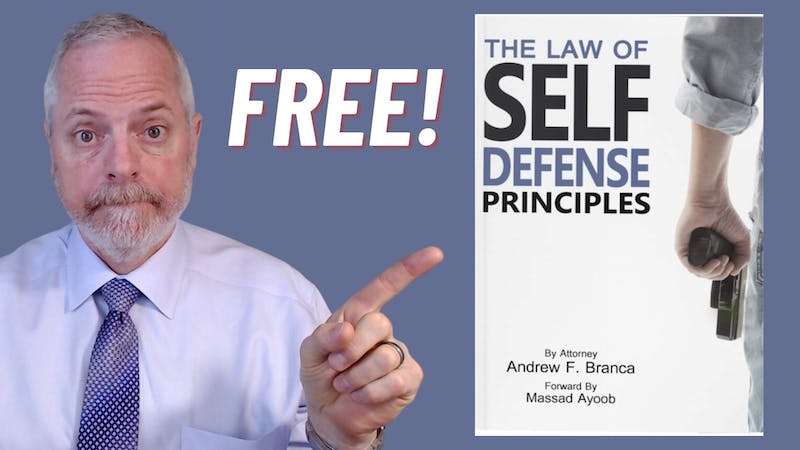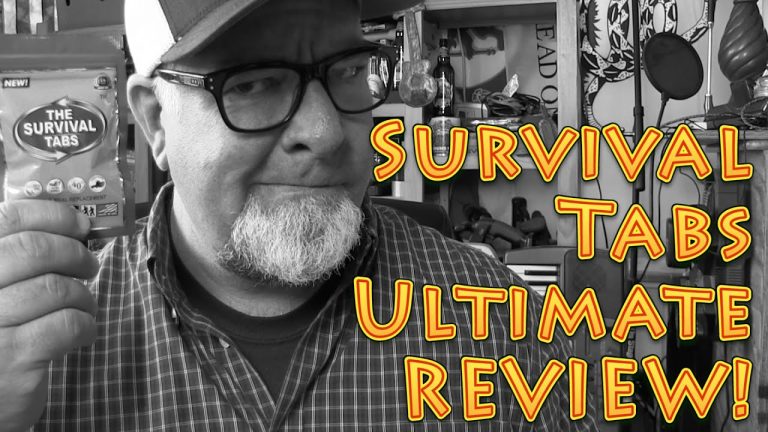This past Saturday, October 28, hockey player Adam Johnson had his neck fatally slashed by the ice skate of opposing player Matt Petgrave. The event was captured on video, which we’ll share in today’s show. CAUTION: The video shows the infliction of a fatal injury.
The legal questions then arise: First, was this an intentional use of force by Petgrave on Johnson? Second, if intentional, would this killing be murder, manslaughter, or negligent homicide?
These questions require both a legal and factual analysis in order to arrive at a reasoned answer, and we’ll tackle both of those in the context of the video of the event in today’s show.
I do note that this event took place in the United Kingdom, not America. As is our practice, however, we’ll analyze this event using American principles of law.
[TRANSCRIPT BELOW]
RESOURCES
Raw video from hockey game
Learn the Self-Defense Law you NEED to STOP a MASS SHOOTER, for FREE!
Grab your own copy of our best-selling guide to self-defense law for FREE!
“The Law of Self Defense: Principles” is our best-selling, plain-English explanation of your legal privilege to use even deadly force in defense of yourself, your family, and others–INCLUDING FROM MASS SHOOTERS!
DON’T WAIT until a mass shooter hits YOUR TOWN–by then it will be TOO LATE!
Get your copy for FREE (except for S&H) by clicking the image or link below RIGHT NOW!
“The Law of Self Defense: Principles” FREE (+ S&H)
[TRANSCRIPT BELOW]
There is only ONE self-defense “insurance” provider that I PERSONALLY TRUST!
There are lots of self-defense “insurance” companies out there. Some are hot garbage. Some have limited resources. Some are simply, in my view, untrustworthy. But there is ONE that I PERSONALLY TRUST to protect myself and my family. LEARN WHY by clicking the image or link below:
Disclaimer – Content is for educational & entertainment purposes only, and does not constitute legal advice.
Copyright Disclaimer Under Section 107 of the Copyright Act 1976, allowance is made for “fair use” for purposes such as criticism, comment, news reporting, teaching, scholarship, and research. Fair use is a use permitted by copyright statute that might otherwise be infringing. Non-profit, educational or personal use tips the balance in favor of fair use.
Transcript
(PDF Link)
NOTE: All LOSD video/podcast transcripts are prepared in rough form, provided solely for our members’ convenience & documentation, and are not thoroughly reviewed for accuracy. Refer to the original video/podcast for the authoritative form of this content.
BEGIN
Welcome, everybody. Welcome to today’s episode of the law of self defense. I am so glad you are all here. I didn’t want to display that quite yet. Attorney Andrew Branca here for the law of self defense. Thank you. Thank you very much. And today, of course, we’re here to talk about the hockey homicide that occurred this past Saturday in the United Kingdom.
We have video of that rather horrific event. Warning, warning, warning. Thank you. You’ll see someone fatally injured in the video. So if that’s not your cup of tea, this may not be the show for you. Uh, what we’ll mostly be focusing on today, however, is, uh, arguably not so much the, the event itself, but the factual and legal questions that would need to be handled in evaluating what we have here, whether we have an accident, whether we have a negligence, whether we have a manslaughter, whether we have a An actual intentional homicide, an intentional killing, unlawful killing.
Uh, so what I can do is break down the law for all of you, which is what we’ll do today. And then. You’ll have to each look at the video yourself, just like a jury would do, and determine where on that spectrum of mental states you believe that the pet grave, the, um, the, the hockey player who skate inflicted the fatal injury, where on that scale of mental states and therefore where on the scale of legal liability, uh, pet Graves conduct would fall.
This is much as how these things are done in a trial. So the, the judge instructs the trial on what the legal principles are. The jury is the finder of fact, determines what they believe the facts to be. And when you plug the flag, the facts into the legal algorithm, that’s how you get to a reasoned verdict at the end.
So that’s all of what we’ll talk about today. I do apologize. I’m still a bit under the weather. I feel much better. Uh, I finally have some, some drugs that ought to help. And, uh, I expect to, uh, improve substantially over the next couple of days, still a little horse, not much I can do about that. Uh, so with that out of the way, let’s go ahead and launch the formal start of today’s show.
And here we are, uh, before we jump into things, we do, of course, have a sponsor of today’s show and that sponsor. Is none other than law of self defense itself. In particular, our book, the law of self defense principles. We’d like to make this book available to you for free. This is a plain English handbook on what the legal boundaries are for the use of force in defense of yourself, your family, the property applies in all 50 States.
Of course it is us specific. Sorry about that. Rest of the world. All I do is us law. Uh, we’d like to get this to you for free. Check it out on Amazon. There’s a lot of reviews, 1500 reviews, five star rated. It’s a bestseller in its category on Amazon, but don’t buy it on Amazon. They’ll charge you, um, or the cost of the book.
I think they charged 25 and shipping and handling. All we ask for is that you cover the cost of shipping the book to you. We’ll eat the cost of the book itself. So you don’t have to pay for both. There’s a little link there in the bottom of the screen. Law of self defense. com slash free book is how you get your, it’s an actual physical book folks.
It’s not some kind of PDF download. Get your own copy for free at law. Self defense. com slash free book. Uh, now having said the book is particular to American law, I should point out that this event took place on a hockey rink in the United Kingdom. So it’s not subject to American law. Um, unfortunately, I don’t know any UK law.
Now, we often analyze use of force events, uh, from around the world here at Law Self Defense, but we always analyze them through an American legal perspective. Um, I expect English law would be very similar. I mean, we have the same foundations, but, uh, if you want a practical application of the law to this event in the UK, from a UK perspective, I encourage you to contact a UK attorney.
What you’ll get here. Is how American law would apply if this had occurred in an American jurisdiction. Uh, let’s see.
Okay. So I suppose we should start. I suppose we should start with the video. Again, the video is a, is a bit gruesome. It’s not very long, but you’ll see someone mortally injured. Um, the quality is not great. The video I have appears to have been something that was like filmed with a smartphone off a TV screen.
So it’s unusually grainy. I’ll play it for you. We’ll do a little. You know, enlargement and, um, see what we can see. You will see blood on the ice. You’ll see blood on the player’s shirt, the victim’s shirt here. Um, and, uh, and all of that unfortunate detail. Now I should mention the, the, um, hockey player who died as a result of this injury.
His name is Adam Johnson. 34 years old, something like that. Uh, the hockey player who inflicted the fatal injury. His name is Matt Petgrave. Weird that the guy who caused the killings. Last name would include the word grave, but that’s the simulation we all live in, I suppose. So certainly my condolences to the family of Adam Johnson.
Oh, good heavens. Hold on one folks.
It is tough to have a respiratory infection when you talk for a living. I’ll tell you that much.
So I may have to keep this shorter than I normally would, which I’m sure many of you would not mind.
So before I jump into the various mental states that might apply here, actually, I’ll come back to that in just a moment. Hold on, turn off the notifications on my computer.
Okay. So we’re going to see the hockey players here on the screen.
I will see the players come in here really from the, uh. The red player, Petgrave, who inflicted the injury, I believe he comes in from the lower left, he’s in red. Uh, the, the player who will be the victim here, he’s in white. Again, it’s all very small and very grainy. I’ll go ahead and play the video and then see if we can’t, uh, zoom in a little bit.
Here we go. There’s the hit. Right there. Immediately, there’s blood on the floor. The, the neck has been slashed. The skates are like razor blades. More blood on the ice. A lot of blood on the shirt. That’s a mortal injury.
So let me see if I can zoom in a little bit on the actual… Moment of impact. There’s the kick.
Oh, it’s not really letting me zoom in.
Sorry, folks. I’m not sure it helps all that much to tell you the truth because it just remains kind of grainy. Now, what I see when I look at this is what appears very much to be a deliberate, like a karate style sidekick, high kick to the victim’s neck here. Maybe that’s not what happened. Different people have had different perspectives.
I’ve seen on Twitter, some people are saying this is the kind of accident that happens in hockey. And it is worth mentioning that when you engage in a contact sport like hockey, you are consenting to a certain amount of force being used on you, just like you would in playing football, for example. And, um, let me go ahead and take that off.
So when you’re playing hockey, you’re implicitly giving consent to other people to hit you. That’s part of the game. It’s important to note, however, that we’re talking about. The hitting that’s appropriate to the game. That’s part of a normal concurrence of the game. This isn’t rollerball. Those of you of a certain age who are familiar with the movie rollerball.
Um, no one’s consenting here to a ice skate across the neck. No one. No one’s consenting here to deadly force being used upon them. Um, and and whether these things have occasionally happened in the past, folks, it’s not really a reflection of what’s happened here. Um, yeah. I know there’s been other serious injuries, which ice skates in, uh, in hockey, but they’re so rare in the context of the number of minutes of hockey that are played every year that it’s clearly not an accepted part of the game if it was done intentionally.
Now, before we dive into the various mental states involved, I want to differentiate, uh, these criminal mental states from similar terms that are used in a different context. Um, there’s a. Medical examiners will determine a manner and mechanism of death or manner and means of death. This is a medical finding, but it often uses terms that are appear synonymous with legal terms of art, and they’re really not for legal purposes.
So I’ll describe the manners of death that a prosecutor, sorry, that a medical examiner may determine upon autopsy of a dead person. One may simply be undetermined. We don’t know the manner of death, and this can happen when, say, a body is found in the Rocky Mountains after, you know, in the spring when the snows melt.
And there’s just, there’s not much to go on from what maybe they’ve been savaged by animals after they were dead. There’s not much to go on in terms of manner of death. So undetermined can be a manner of death. Homicide can be a manner of death, but homicide is not being used in a legal context here.
Homicide simply means here that one person killed another person. And I’m going to circle back to that in a moment. Suicide of course, means the person killed themselves, um, accidental. Is an unintentional killing. And this could be an industrial accident. Uh, it could be
a, uh, a drug overdose would typically be an accident killing that person. It’s not a suicide because they were not trying to die. They were recreationally consuming drugs and consume too much or the wrong type or whatever. That is a result accidental. And then we have natural causes of death, uh, simply, uh, kind of medical causes of death.
So somebody has a stroke, somebody has a heart attack. That’s the manner of death. The means of death would be the mechanical means by which these things were inflicted. So it could be suicide by gunshot wound, uh, homicide by gunshot wound, natural cause of death by ischemic stroke, that kind of thing. But these are the manners of death.
Now, when we get back to homicide, just because one person killed another does not mean that was a crime. There are lawful homicides and unlawful homicides. So a An intentional killing done in the absence of justification would just be a murder. That’s an unlawful homicide murder. There’s various forms of unlawful homicides.
We’ll get to those in a minute, but an intentional killing done in self defense is not a murder. It’s still a homicide, but it’s a justified killing. That’s not a crime because it was done in justified self defense. So, um, all murders are homicides, but not all homicides are murder. So hopefully that makes sense.
Okay. I have another set of slides here.
See if these are the ones I want. Yes. Let’s take a look at these instead. So now I’d like to talk about various kinds of mental states that a person might have when they cause a death of another. Um, one is they may have essentially no mental state. This is a situation in which there is no legal liability.
At all for having caused the death, which may seem weird, right? How can you cause someone’s death and have zero legal liability? Well, if it’s what’s called a genuine accident, and I mean, accident here in the technical legal sense, not the colloquial way we do it, which just means you didn’t want something to happen.
There can be legal liability if you cause a death. Even if you didn’t want the death to happen, accident refers to the causing of a death under circumstances in which would be completely unforeseeable to anybody that the death would result. A common example I use is, um, say you visit your elderly aunt in her apartment building.
And while you’re there, she asks you, Hey, could you move that heavy bureau from one side of my apartment to the other side of the apartment? You’re happy to help your aunt. So you pick up the heavy bureau, you carry it across the room, you put it down in the new location. And it falls through the floor and kills the person in the apartment below.
Now, assuming you had no reason to know that the floor joists were rotten with termites, you would know it was impossible, unforeseeable to you that placing the bureau there would result in this fatal outcome. That’s a pure. Accident a genuine accident for which you would have zero legal liability because it was the outcome was completely unforeseeable by anybody, no matter how reasonable they might otherwise be an accidents carry no legal liability, whatever accidents happen s happens, but it does need to be something for which the outcome was completely unforeseeable to a reasonable and prudent person.
The next level of mental state, this is a increasing hierarchy of responsibilities is negligence. Negligence occurs when you, a reasonable person would have foreseen this outcome as being likely, reasonably likely you didn’t for whatever reason, you were not Thinking about this, but a reasonable person would have expected.
This can happen. Um, this might be, um, uh, say, for example, your aunt didn’t ask you to move the bureau, but she asked you to put a very heavy window air conditioner in her window, really way too heavy for any one person to manage by themselves. But you don’t have anybody with you. You decide you’ll do the best you can and you’re installing the air conditioner in the window.
And sure enough, you lose control of it because it’s too heavy and it falls out and kill someone on the sidewalk. It could be argued that that was a foreseeable outcome. Now you are not foreseeing that outcome. You were not thinking of that, but a reasonable and prudent person would have foreseen that outcome.
And because you were acting unreasonably because you violated the general duty of not harming others, when it would be foreseeable that harm could result, that’s a mental state of negligence. Now negligence is. Not sufficient for criminal liability. So you don’t go to jail for negligence, but it is sufficient for civil liability.
So you wouldn’t be prosecuted for, uh, a criminal killing, but you would be sued for a wrongful death action. And you’d be assuming that you were found liable. You’d be expected to pay whatever compensation the jury or the court decided would be appropriate for the wrongful death of the person you killed.
So that’s negligence. You were not foreseeing a risk, but a reasonable and prudent person would have foreseen that risk. Once we get past negligence, we begin to enter the criminal zone of mental states. One of these is something that’s often referred to as criminal negligence. What’s the difference between negligence and criminal negligence?
Well, negligence requires a deviation from a standard of care. We all have a legal duty not to cause harm to others. Criminally negligent is a gross deviation from a standard of care. And how does that typically exist in the real world? It’s when you’re, you’re engaged in conduct that is inherently dangerous.
You’re still not thinking. You don’t have a mental state in which you’re thinking, Wow, I’m creating a danger to people. You’re handling inherently dangerous instruments like a firearm. So it’s very difficult actually to unintentionally kill someone with the firearm and have it not be criminal because the fact that you’re handling a firearm pretty much automatically bumps it up from negligence, only civil liability.
To criminal negligence, uh, criminal liability, and that would include firearms, explosives, dangerous chemicals, things that are inherently dangerous.
Next, we have recklessness. Recklessness is different than criminal negligence in the sense that a reckless person knows that they’re creating a risk. The criminally negligent person doesn’t. They should have, but they didn’t. The reckless person knows they’re creating an unjustified risk of death to others.
And they engage in the conduct anyway. They ignore the risk and death results. A classic example of this might be, um, drunk driving. So you get drunk, you get behind the wheel of a car. You’re not trying to run anybody home over. You don’t have any intent to run anybody over. You’re not trying to cause harm to anybody.
You’re just trying to get home drunk from the bar. But we all know that when you’re driving drunk, you’re creating an unjustified risk of death to others. And then if death results, your reckless conduct is the cause of that death. And it would be a reckless. Then we have intentional killing. Now, an intentional killing is when you form an intent to take another person’s life.
And here we’ll presume that there’s no justification. There’s no self defense justification here. If it is justified, well, it can be intentional. Every day of the week and twice on Sunday. And if it’s justified self defense, it’s still not a crime. But if you can’t be justified, if it’s an intentional killing, then it would simply be a murder.
Now, there is a step back down. You’ll see there’s a gap there in a slide between reckless and intentional, and that occurs under circumstances of what’s commonly referred to as adequate provocation. So an intentional killing is a crime. Cold blooded murder. You make the decision in your head. You form the specific intent to take that person’s life, or at least, uh, to use deadly force upon them.
It’s not actually necessary. You want them to die. Um, but we’re all. We’re all presumed to intend the reasonable, reasonably foreseeable consequences of our conduct. So if you shoot someone without justification, you may not want them to die, but it’s nevertheless an intentional killing if they die as a result of the gunshot.
But we can think of it as a cold blooded killing. You made the decision, however mean it was, it was some kind of rational decision, uh, to take that person’s life, to use deadly force upon them. You do that, they die as a result. And by the way, this intent can form in an instant. It doesn’t require, you know, a shopping list of chloroform clothesline, duct tape, all that kind of stuff that would obviously be evidence of intent, but you don’t need all that intent can happen in a second.
Someone could shove you and you pull out a gun and shoot them. That’s that’s an intentional killing, arguably, but but if there’s evidence to support an intentional killing, the defense might argue. That this should be mitigated because there was adequate provocation. What is adequate provocation?
Adequate provocation are circumstances that replace the cold blooded killing of murder with a hot blooded killing. So the killing was committed in what’s often called the heat of passion. Uh, this classic example of this is a husband who comes home and finds his wife in bed with a lover and he whips out a gun and he shoots them both.
That’s not a lawful killing, but the law will often mitigate that killing from murder to manslaughter because of the heat of passion. Often if there’s a killing in the course of some kind of ongoing physical fight. The fight itself might be adequate provocation that would mitigate murder to manslaughter.
Often the way this is done from a procedural matter is you’re actually convicted of murder and then the defense has to argue, uh, after, after the conviction for murder, that there’s, there’s evidence to support adequate provocation and therefore the murder should be mitigated to manslaughter. You’re not let go, you’re still convicted of manslaughter, but Man’s letter is better than murder.
So which of these would apply here in the context of this video? Well, I don’t know. That’s a, that’s a determination of fact. That a jury would have to come to and once they determine the mental state, it gets plugged into this legal algorithm and we end up with a some determination of legal liability on the other end.
And I think reasonable people can and do disagree on this particular
on this particular event. So when I see this, and by the way, I’ve, I’ve never played hockey. I’m not a fan of hockey. I don’t understand how people can watch it. To me, it’s terrible. It’s, it’s, it’s, yeah. Excruciatingly boring. But if you like hockey, that’s fine. No worries. But when I watch this, what I see is effectively a deliberate sidekick by Pet Grave to Adam Johnson’s neck right there.
To me, that looks intentional. Now, is it possible that somehow Pet Grave, I don’t know, got his other skate stuck in the ice? And that caused his hips to swivel and his skate to come up. It doesn’t look that way to me, but that’s the argument the defense would make because the defense would be trying to argue that it was some lesser degree of mental state of intent than an intentional killing.
I mean, maybe it was an intentional killing, but of course, the defense doesn’t want to accept that that that’s what the prosecution would be arguing. Um, the defense might argue, well, it was intentional, but these two had a, some kind of existing animus, or they had just had a fight prior to this, or, uh, Johnson had just committed some, um, nasty hit against Petgrave.
And so Petgrave was in a state of passion, was in a state of hot blood. So it shouldn’t be murder, even though it was intentional, uh, because it should be mitigated down to manslaughter. Or the defense might argue, listen, this was. Not really intentional at all at worst Petgrave was trying to hit him with the skate But like in the chest still not I would presume not an allowed hit in hockey I presume you’re not allowed to use your skates on each other’s bodies like that But the defense would argue look he was trying to hurt him Uh, but not fatally, not to the neck.
And then the argument would be, well, that could be reckless conduct. So he knew, you know, if you try to go hit someone in the chest with a skate, it’s possible you’re going to hit him in the neck, the next, not that far away. So, you know, you’re creating the risk of a fatal injury. It’s not your intent, but you know, you’re creating the risk, much like the drunk driving scenario.
You ignore the risk, you cause the death. It’s a reckless killing. Maybe it’s not reckless. Maybe it’s simply criminally negligent. Maybe didn’t know that he was creating this risk. He should have, but he didn’t and he was creating the risk with something that could be characterized under the circumstances as inherently dangerous.
The razor sharp blade of an ice skate. That might be criminal negligence or it could simply be negligence. He should have known he was creating a risk. He really didn’t, but he should have a reasonable person would have. And if it’s only negligent, there’s no criminal liability at all. There’s only potentially civil liability.
And of course it could be a genuine accident that this was completely unforeseeable that this would happen in which case there would be no legal liability at all. An accident is a legal defense to any kind of use of force charge. Just like self defense is a legal defense.
Now, how do these various mental states
translate into crimes? I have yet another set of slides just for this purpose, folks. And by the way, part of this, how do you determine what the mental state is? Which of these applies? And by the way, this slide is a little imperfect. That civil bracket there is also covering accident. It should not be covering accident.
Accident creates no legal liability, not even civil liability. How would a jury be told to evaluate what mental state? How do they decide? Well, it’s up to the jury based on the facts available to them. Those facts would be this video. Those facts would be other evidence. Uh, my understanding is that Peck grave was one of the most penalized.
Hockey players in this league. So he had a reputation for bad hits, nasty hits. They can certainly take that into consideration. Um, it may be Petgrave may testify and, uh, say have some kind of explanation for why this happened. Uh, they, the defense might bring in expert witnesses on hockey for how this happened.
Uh, but one way or another, the jury would be tasked with coming to some determination of mental state that would be plugged into the algorithm program to arrive at some kind of verdict. Of some level of crime or no crime, depending on if the mental state were low enough. And by the way, folks, this is today’s show is very much what I do when I’m an expert witness in a trial.
So when I’m an expert witness in the trial, I don’t tell the jury what the mental state is. I don’t tell the jury what the answer is. That’s not my job. My job is to bring clarity to what the legal question is. So I explained the legal question and the outcome of the legal question depends on the input.
The input is the mental state. So I tell the jury, listen, I can’t tell you what you should determine to be the ultimate finding effect. What the mental state is of the defendant in this trial. You have to decide that based on other evidence that you’ve heard in this trial. What I can tell you is. If you arrive at one of these mental states that determines what the legal outcome will be, because the legal question is essentially fixed.
Once you have the input, the input is the mental state here. So let’s look at these and I’m only going to look in the criminal context here because I’m accident has no legal liability negligence is no criminal liability only civil. But in terms of the, uh, the basically the 4 mental states with criminal liability, the least of those was.
Criminal negligence. And I’m going to use a Colorado law here. I mean, most states are similar, but just for illustrative purposes. Um, so in Colorado, we would call that criminally negligent homicide. So you weren’t deliberately aware of and ignoring a risk you were creating, but you should have known you were creating that risk and you were doing something that was inherently dangerous, right?
Criminal negligence. If you have a criminally negligent mental state, you’re guilty of And you kill someone as a result. It’s criminally negligent homicide. And under Colorado law, that would be a maximum three years in prison. So the least of the criminal mental states. The least maximum sentence recklessness.
So remember recklessness is when, you know, you’re creating a risk of death and unjustified risk of death to others. You engage in the conduct anyway, and then death results. Well, in the Colorado law and most States, if your mental state was one of recklessness, you’re guilty of involuntary manslaughter.
Now it’s involuntary. We call it that because you were not intending to harm anyone to use force against anyone. This is the drunk driving example. You’re drunk at the bar. You get behind the wheel. You’re not intending to run anybody over. You just want to get home, but you know, you’re creating that unjustified risk of death.
You engage in the conduct. Anyway, you kill someone as a result, involuntary manslaughter under Colorado law, that would be good for a maximum of six years. Then we have the circumstance of adequate provocation. You did intend use harm against that person, potentially lethal harm, foreseeably lethal harm, but you did it in a state of hot blood in the heat of passion.
You would just had a confrontation with this person. So your blood was up that’s voluntary manslaughter distinguished from involuntary, because now you are intending to use 12 years.
Under Colorado law, and then, of course, we have the cold blooded intentional killing. There was no adequate provocation. You did intend to use foreseeably deadly force against that person and death results. That’s simply murder Massachusetts. I’m sorry. Colorado would call that second degree murder. Um. In most states, first degree murder is capital murder, and Colorado has gotten rid of the death sentence here.
So we don’t really have first degree murder anymore. Secondary murder is effectively the highest degree. Good for up to 24 years in prison. I guess we still do have first degree murder, but you can’t get the death sentence anymore. So first degree murder would be There’s some aggravating circumstances beyond just an intentional killing.
And then you’d be looking at the potential of life in prison without possibility of early release. So what is Petgrave guilty of here? What crime? Well, it depends on what you believe his mental state to be, right? If you believe this was a genuine accident, absolutely unforeseeable. And I guess it could have been right.
His, his other skate could have gotten stuck in the ice in a way that was completely unpredictable, swiveled his hips. Beyond his ability to control the skate just came up and happened to hit Johnson in the neck, zero legal liability. If you believe it was a genuine accident that was completely unforeseeable to Petgrave, if you believe Petgrave should have foreseen the risk, didn’t actually foresee it, but should have, then it would be negligence and he might be civilly liable for causing an unwarranted death, but not criminally liable.
If you believe it was negligence in the context of inherently dangerous conduct. Then it might be criminally negligent homicide. If you believe he knew he was creating a risk of death, didn’t really intend death, but knew he was creating an unjust, unjustified risk of death and engaged in the conduct anyway, then it could be involuntary manslaughter.
If you believe he just intentionally spliced his ice skate across. Um, Johnson’s neck, straight up murder, unless, unless the defense can argue that there was adequate provocation, there was heat of passion, and therefore the murder should be mitigated down to manslaughter. So, I don’t have an answer for what the outcome should be here.
I can tell you if I were in a jury, this looks bad to me, it looks intentional, but have I heard from hockey experts, expert witnesses brought by the defense who could explain to me that actually this kind of stuff happens unintentionally all the time? Um, I’m amenable to persuasion of I heard pet grave testify, and he was a compelling witness on his own behalf, explaining how this was not an intentional act of his.
I’m amenable to persuasion. It looks awful to me. Um, but that’s why we have trials. And that’s why we have juries. Okay. So at this point, I think I will take a look at the comments and questions that have come in from the chat. I will mention that of course we answer comments and questions from our law self defense members.
We live stream this to our law self defense members on the member dashboard. There’s a chat function there and they get their comments and questions addressed for free. Every live stream. Uh, if you’re watching this on YouTube and you’d like to Pose a question or comment for me, a super chat of a minimum of 10.
I don’t encourage you to do that because for less than 10, you could be a law self defense member for an entire month and get an entire month’s worth of your comments and questions answered. In fact, you can become a law self defense member. Try it out for two weeks for just 99 cents. As you see here up on the screen, you can take advantage of that two week trial for 99 cents at law of self defense.
com slash trial. If you stay a member after the two weeks, it’s only about 30 cents a day, folks. It’s less than 10 a month to be a law self defense member and get all your comments and questions addressed for free as a member, as opposed to 10 YouTube super chats. Again, that’s at law self defense. com All right, let’s take a look here.
Uh,
uh, attorney Steve Gosney is in the chat. Hey Steve, how you doing, man? Uh, Steve’s a, an attorney down in Florida, uh, works for the public defender’s office, primarily at the appeals level. Steve has a number of excellent books. That I strongly recommend. You can learn more about those at Steve Gosney. com. Uh, Steve asked, does anybody know what disguise prior bad acts were?
Um, I, I guess in hockey, they call them penalty minutes, Steve. Um, I believe they’re assigned for bad behavior. They take the player off the ice so that his team is playing a player short for a certain number of minutes. And, uh, and that’s for bad behavior. Yeah. I’m still 60, but I’m getting better. Uh, Zakuza says you’re always going to have the goons on the ice and they’re going to be some dirty plays here and there, but this is something completely different.
It looks different to me. And of course, hockey is famous for having dirty players. I mean, those dirty players play a role in hockey, just like fights, play a role in hockey. It’s part of the sport. It’s part of the theater. And arguably hockey players consent to a certain degree of even kind of off the roster violence, right?
Like fistfights or not. Officially part of hockey, but they’re kind of unofficially part of hockey. So if you found yourself punched by another player in a hockey game, it would be hard to justify. You had no idea that was a possibility in the game. I would suggest that most hockey players have effectively consented to finding themselves in a fistfight on the ice.
But none of them have consented to an ice skate across the neck, folks. Um, Sakusa says, uh, Johnson was 29 years old. Yeah, fair enough. 29. I believe that’s correct.
Let’s see. ZA says nothing would cause Pet Grave’s leg to kick up like that other than Pet grave doing it on purpose. It looks that way to me. Uh, but again, I would be amenable to persuasion if someone could make a compelling argument to the contrary,
uh oh. Steve had, Steve of course, has an article. Steve, did you write the article? You just linked in the member chat? Steve has an article on an amazing breadth of legal issues, especially criminal legal issues.
Yeah, Steve says consent in this context would only extend to expected contact from traditional play of sport, not a killing slash. Yep. That’s right,
as accuses says. Hypothetically, if there was an off ice altercation between the two players, a lawyer could link that to being intent to commit a crime under the guise of being a freak accident. Yeah. So say these 2 guys were fighting off the ice over the same girlfriend. That’s what I mean by some existing animus.
So there could, I mean, normally that wouldn’t qualify as adequate provocation. So 1 of the concepts that Involved in adequate provocation is because it’s really referring to a hot blooded state of mind, as opposed to a cold blooded state of mind. It can’t just be some pre existing animus that’s in the background, because you have to be in a hot state of blood.
So it has to be some offense or perceived defense that’s just occurred. And you’re still in that hot state of blood, hot blooded state of mind if there’s what’s referred to as a cooling off period. Well, then you’re no longer in a state of passion. It’s no longer a hot blooded use of force. So, uh, one man insults the other, insults his mother, whatever.
And the other man strikes back immediately. Arguably, you might argue adequate provocation. That insult is made. And then the use of force occurs a week later. That’s no longer adequate provocation because there’s been this cooling off period.
Uh, let’s see.
Yeah. I mean, what’s most disturbing to me is, is this, the skate coming up to head level there, um, in what looks like a, um, you know, I’ve, when I was a youth, I studied karate, looks like a karate sidekick to me.
Uh, if the intent wasn’t to kill, but just to seriously injure the more productive player, well, if you intend to cause serious injury and someone dies as a result, that’s no different than intending to kill.
Uh, let’s see.
All right. I think I answered all the member questions. Let me take a look at the super chat and see if there’s anything I need to address there. I hope there isn’t. I hope instead of paying YouTube 10 to post one question, you’re instead spending 99 cents to become a law self defense member for a two week trial period.
Get all your questions answered.
Let’s see. And it looks like there’s nothing from today, October 31st, by the way, happy Halloween, everybody. Happy Halloween, another Halloween in the books. I hope everybody stays safe. If you have little kids, I hope they enjoy the trick of trading and that made the dentist’s yachts worth of money from all the cavities that will result, which I presume is the actual purpose of Halloween.
It must be a conspiracy of dentist. All right, folks. Well, again, as you can tell, I’m still a little under the weather. I am getting much better. Um, I expect to do another live show tomorrow. I think tomorrow I’ll cover this. Uh, shooting that occurred in Brooklyn. That’s been all over Twitter. Uh, that’ll probably be tomorrow’s show.
Um, so we’ll cover that from a perspective of self defense, murder, whatever it might be. We’ll break that down. I think that’ll be the topic of tomorrow’s show. One benefit of being sick, I lost some weight. So that’s one benefit of being sick. Another benefit is because I wasn’t doing shows, I have a lot of content backed up.
So I’ll do my best to catch up on all of that for all of you. And with that out of the way, folks, I’ll just remind all of you that if you carry a gun, so you’re hard to kill, carry a knife, so you’re hard to kill, carry an ice skate, so you’re hard to kill, carry pepper spray, study jujitsu, so you’re hard to kill.
That’s why I do all those things, except for the ice skating thing, ice skating is for children. Um, no offense. Um, that’s why I do all those things. So I’m hard to kill. So my family is hard to kill you. Then you also owe it to yourself and your family to make sure, you know, the law. So you’re hard to convict as well.
One way to know the law is to get our free book right there at the bottom of the screen, folks, law, self defense principles. We only ask that you cover the cost shipping. Get that at law, self defense. com slash free book. And until tomorrow, I remain a Turner
until tomorrow. I remain attorney Andrew Branca for law, self defense. They say.
END



















